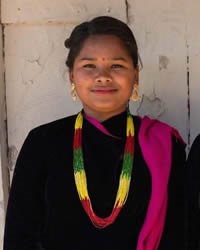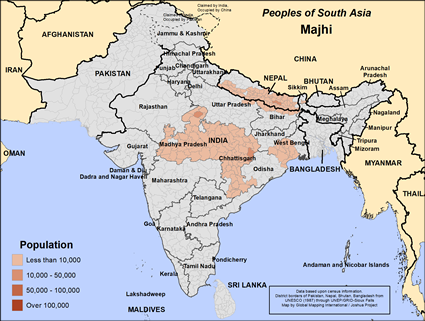The Majhis are one of the indigenous peoples of the nation of Nepal - possessing their own language, dress, culture, etc. Majhis are not only polite and shy but also very much friendly and helpful. Due to these points they are defeated in many ways and the so called high castes have exploited them excessively. From the dawn of time the Majhi have had a special and intimate relationship with the rivers of Nepal. The main traditional occupation of the Majhi people is boat building and river transportation services in Nepal, with most Majhi living in the inner Terai near rivers. On average, Majhi people are dark brown in skin complexion, medium in height and well built, they have the classic Mongoloid features typical of East Asia.
Nepal is divided in 3 parts horizontally that is Mountain, Hill and Terai. And most of the Majhis have lived in Inner Terai. Except this they live some in plain Terai and Mountain areas also. We can find that most of the Majhis are located just near the rivers shore. In Nepal a group of rivers is called Saptakoshi. It is made out of 7 rivers of Nepal which is Indrawati, Bhotekoshi, Tamakoshi, Sunkoshi, Arun, Barun and Likhu respectively. And these particular rivers are the main location of Majhi people of Nepal.
The Majhi language is categorized as 'Indo-European' and is declining due to backwardness and modernism. It is still widely spoken, however, in Kavrepalanchowk, Ramechhap, Dolakha, Okaldhunga and Khotang districts. It is Majhi's desire that the education of Majhis be in their mother language.
They are patrilineal though in many ways Majhi women are powerful in decision making. Most of the men follow whatever the women prescribe. Though it is they equally share the responsibilities whether it is outside or inside of the house. They catch fish in the rivers for feeding by the help of self-made hooks and nets. Majhis have their own traditional songs, dances and many ritual functions. They have strong we feeling among them. They are proud to be Majhi.
The ancestral occupation of the Majhi people is to help other people in crossing the many rivers of Nepal in their Majhi made boats. By doing this they get coins from the benefiters. Fishing was for their own sustenance. They do not farm fish in pools, just freely catch fish from the rivers. The Majhi also farm but they don't have enough land to fulfill their daily needs, the women especially sell "Marcha" an ayurvedic medicine for making wine and jand i.e. a special wine making of cooked corns in the markets, as well as mats made of pater. Majhi products are of exceptional quality. Today a tragedy is unfolding in Nepal. Modern bridges and government interference in their traditional working areas is destroying the traditional Majhi way of life.
Majhis are endogamous. They explicitly prohibited to marry outside of their clan, caste and tribes. Most Majhi people reside in ancestral places in simple round houses made of stone or clay - having a single door; and always very close to each other. They use straws for roof. While making a new house a Majhi will check to see if the house spot is suitable or not by mixing the soil of the four corners of the selected site with MARCHA (medicine to prepare JAND). If the soil is tasty, it is believed that the chosen house spot is suitable, if not - it is rejected as an unsuitable location.
The Majhi have limited educational opportunities. They have a very low literacy level, no Majhi has a master's degree, only 15 have bachelor's degrees, 35 have certificate level qualifications and 130 have the qualification of S.L.C. (School Leaving Certificate).
Tantrik religion is the Majhi religion, the Majhi have no Temples or man-made places of worship, they establish Gods or Godesses at the base of a tree near a river, a primarily animist religious belief. The main god of the Majhi people is Gharbhimsen, other principal gods are Goresiddhi, Gaidu, Mahadev, Jaurekhee, Setidevi, Ardev, Jangali and Shikari, Totala flowers are vitally important in the worship of these deities.
Majhis are pantheist. They give worship to creatures like Sime, Bhume, Bhut-Pret, Chhauda, Kancho Bayu, Pisach etc. They believe in the soul, hell and heaven. After the death of a person, they believe that the soul of their dead relatives and ancestrals visit to their house for many purposes. So Majhi should pray and offer them some pure rice, wine, flowers, fragrantic wood etc. regularly. If something goes wrong in these steps, the soul makes loss of material things of the home. If it is ok, everything will be ok. They believe in witchcraft also. They still practice this. By their witchcraft, they harm thier enemies and block the ways of evils.
Most of the Majhi people are below the poverty line. The economic status of the Majhi is very poor. This is perhaps the most pitiable situation of the proud Majhi people - and the one in most need or urgent attention, modernity, government obstructionism, water pollution and no financial aid from the government of the Nepal - are all causing the Majhi people to sink ever deeper into poverty and despair.
The ancestral occupations that is boating and fishing are now completely replaced due to developmental activities countrywide, however the concerned institutions have not remembered us which is great injustice towards the Majhi people. They even have not sufficient land for agriculture that is why they are living impoverished kind of life. Next tragedy of Majhi people is the lands of stream shores which is free of cost are not belong to any Majhi people, but to other so called high castes have that lands. So, governmental bodies should mainly focus on the Majhi's sustainable development.
Pray the Majhi would see they can enjoy abundant life if they put their trust in Jesus Christ.
Pray for the Lord to intervene in their families, calling people to his side and blessing them in every way.
Pray for loving workers.
Pray for their hearts to be drawn to the Lord of lords.
Pray for a church planting movement to thrive in their communities.
Scripture Prayers for the Majhi in Nepal.
Surya Majhi
| Profile Source: Joshua Project |











